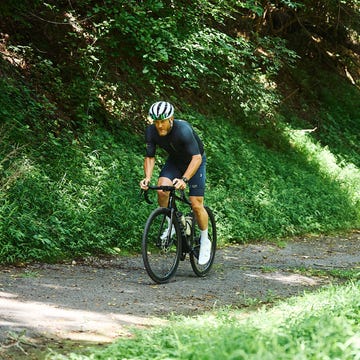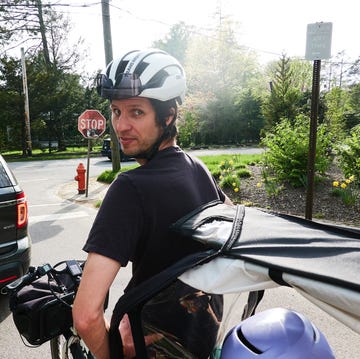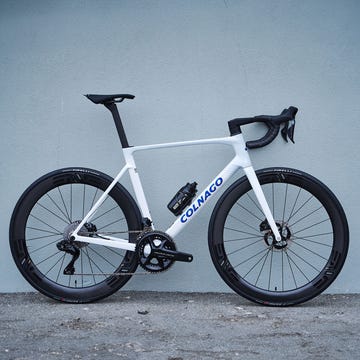For Peloton devotees, Christine D’Ercole needs no introduction. The founding instructor has a following of students inspired by the mindful motivation she brings to every indoor cycling workout she leads on the Peloton platform. But mindfulness isn’t the only skill D’Ercole teaches in her popular indoor cycling classes.
Cadence training is a cornerstone in D’Ercole’s program because in addition to being a master Peloton instructor, she’s also a competitive track cyclist. D’Ercole is masters world champion and multi-time masters national champion, who also competes in the Pro/Am and UCI races at the Valley Preferred Velodrome in Pennsylvania.
How and Why to Do Indoor Cadence Drills
D’Ercole stresses the importance of having a balanced mix of cadences in your drills, and purposefully training the full spectrum of leg speeds in order to ride fast, efficiently, and powerfully. Mastering this particular cycling skill is a big part of her own training out on the pavement, and she includes cadence drills regularly in her classes.
“Higher cadence drills will develop your cardiovascular system while lower cadence drills will develop your muscular endurance,” she says.
Riding indoors on an indoor trainer or stationary bike is D’Ercole’s preferred way to work on cadence drills, and it’s what she recommends to other riders, because it allows for complete focus on the drills and the precise cadence targets, without having the distraction of varied terrain and other people or cars on the road.
D’Ercole is also a big fan of a third way cyclists can train indoors that is often overlooked in favor of fixed indoor trainers: rollers. Riding on rollers is the most beneficial way to train cadence ranges and work on a smooth pedal stroke indoors.
“Rollers allow us to achieve extremely high cadences without much resistance in order to tap into rapid fire muscular contractions and develop handling skills,” she explains. “Whether you’re riding or racing outdoors or not, these drills will train your cardiovascular system and, when loaded with resistance, will challenge your musculoskeletal system to step up.” Even when racing at the Velodrome, D’Ercole and other riders use rollers in their warmup.
To help you smooth out your pedal stroke, D’Ercole shares some of her favorite techniques for keeping her students and her own cadence skills sharp.
High Cadence Spin-Ups During Warmups
Whether warming up her students at the beginning of class, or warming up for a race on the velodrome, D’Ercole always includes spins-ups.
How to do it:
- Start at 80 rpms with light resistance/easy gear, spin smoothly for 1 minute.
- Increase cadence to 85 rpms for 15 seconds.
- Increase cadence to 90 rpms for 15 seconds.
- Increase cadence to 95 rpms for 15 seconds.
- Increase cadence to 100 rpms for 15 seconds.
- Increase cadence to 120 rpms for 30 seconds.
- Return to a cadence of 85 rpms.
- Repeat.
Short Accelerations at the End of Steady Efforts
This technique adds a little extra spice at the end of a long, steady climb on the road or a steady effort with higher resistance on a stationary bike or indoor trainer.
“Think of it as approaching the top of a hill and digging just a little deeper to finish strong,” D’Ercole says.
How to do it:
- When approaching the end of a climb or steady effort, increase cadence as much as possible.
- Hold the high cadence for 10-15 seconds.
- Rest if riding indoors, or if riding out on the road, coast while descending.
Building Variety Into Cadence Drills
Another technique D’Ercole employs regularly in her classes is including a variety of cadence and resistance combinations, pairing high cadence with low resistance, low cadence with high resistance. She adds power as the main target.
“We train quick contractions and cardio load, then time under tension for strength and then we put it all together and produce power,” she says. “The practical application of all of this is to improve cardiovascular and musculoskeletal strength and speed to dig just a little deeper to cross the finish line, or get to the top of the hill, hopefully ahead of your opponent.”
D’Ercole says these drills are useful to add to your training whether you race or not.
How to do it:
- Pedal at a high cadence (100-120 rpms) with low resistance for 2 minutes
- Pedal at a low cadence (70-80 rpms) with high resistance for 2 minutes
- Find the cadence and resistance combination that produces the most power possible for 2 minutes.
- Repeat 2 more times for a total of 3 rounds.
Cadence Ladder Drills
“This [drill] gradually increases the load on the legs and the lungs resulting in muscular endurance and cardiovascular benefits,” D”Ercole says.
How to do it:
- Start in a slower cadence around 60 rpms with moderate resistance for 2 minutes.
- Increase cadence by 5 rpms every 1-2 minutes without turning down the resistance/shifting into a lower gear.
- Continue until you reach a cadence around 90 rpm, about 12 minutes.
- Return to a cadence of 60 rpms.

Natascha Grief is Bicycling’s Health & Fitness Editor. She started in the cycling industry as a bike mechanic a couple of decades ago, earning a couple pro-mechanic certifications and her USA Cycling Race Mechanic license. She went on to apprentice for framebuilder Brent Steelman in her hometown of Redwood City, California before spending several years working for both large and not-so-large cycling brands. She then switched gears and industries to earn multiple personal training certifications while honing her skills as a trainer and coach, specializing in functional training, corrective exercise, and body positive personal training. She began contributing regularly to Runner’s World and Bicycling as a freelance writer in 2020, and joined the editorial staff of Bicycling in 2022.













